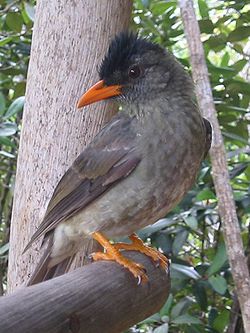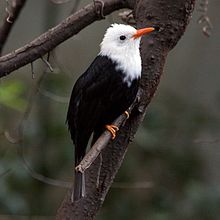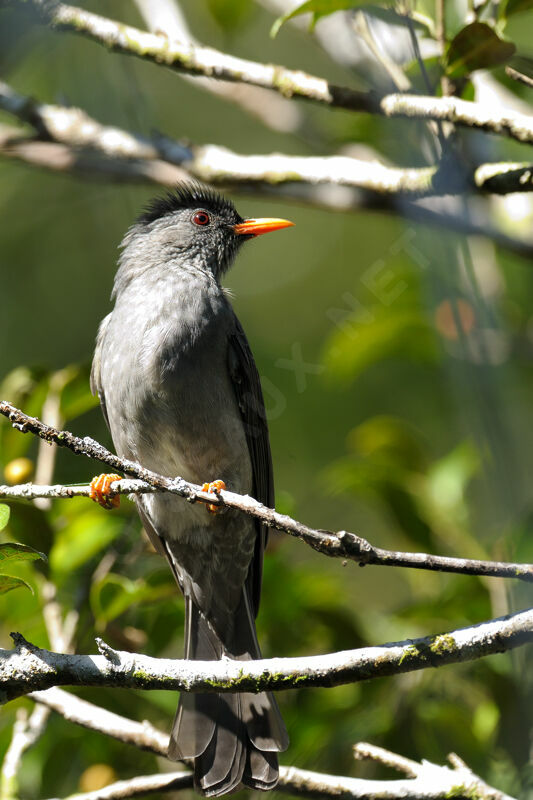| Nicobar Bulbul |
|---|
| Conservation status |
|---|

Near Threatened (IUCN 3.1)
|
| Scientific classification |
|---|
| Kingdom: | Animalia |
| Phylum: | Chordata |
| Class: | Aves |
| Order: | Passeriformes |
| Family: | Pycnonotidae |
| Genus: | Hypsipetes |
| Species: | H. virescens (but see text) |
| Binomial name |
|---|
Hypsipetes virescens
(Blyth, 1845) |
| Synonyms |
|---|
Hypsipetes nicobariensis Moore, 1854 (but see text)
Ixocincla virescens Blyth, 1845
Ixos nicobariensis Moore, 1854 (but see text)
|
Found only on the Nicobar Islands of India, the Nicobar Bulbul is a songbird species in the bulbul family (Pycnonotidae). Its scientific name is Hypsipetes virescens as long as Ixos is recognized as a distinct genus.
Some sources merge Ixos into Hypsipetes, probably based on the major taxonomic error committed in the Sibley taxonomy, where I. virescens – the type species of Ixos – was placed in Hypsipetes. In these works, H. virescens refers to the Sunda Bulbul (properly I. virescens), whose senior homonym was already established by Coenraad Jacob Temminck in 1825, whereas Edward Blyth gave the specific name virescens to the Nicobar Bulbul only in 1845. Thus, the Nicobar Bulbul is often known under the junior synonym Hypsipetes nicobariensis, although this name is not legitimate: it would properly be Ixos nicobariensisif the genera are merged, because Hypsipetes was established after Ixos.
Description
This 20 cm-long bulbul is a rather drab, nondescript species without a crest. Its wings, back and tail are dull dusky green; the face is lighter, and the throat and underside are yellowish-white. The most prominent feature is a sooty-brown cap reaching down to eye height.
It produces chattering calls, similar to those of the Black Bulbul (H. leucocephalus).
Distribution, ecology and status
It is endemic to the Nicobar Islands of India, where it only occurs in the central group, namely Bompoka, Camorta, Katchall, Nancowry,Teressa, Tillanchong and Trinkat; a supposed 19th century record from Pilo Milo in the southern group is nowadays generally dismissed.
Its natural habitats are subtropical and tropical moist lowland primary and secondary forest. It also visits plantations, rural gardens, and occasionally urban areas and grassland. Restricted to a few islands, it is threatened with extinction in the long-term future. In the early 1990s already, though the species was still found on every major island in its range, only single birds or families were usually seen except on Katchall and Teressa. Only in some places on the former it was still as common then as it used to be 100 years ago. At present, it manages to hold its own, but only barely, and habitat loss may have been severe enough to accelerate its decline to dangerous proportions. With altogether a few thousand adult birds remaining, it is classifed as Near Threatened by the IUCN.
Factors affecting decline
Several factors have contributed to this species' decline. For one thing, habitat destruction such as logging for rubber plantations has encroached upon the native forest, and while more sustainable forest uses by humans are tolerated well enough, monocultures are of little use to this island endemic and are utilized only infrequently. An increasing human population has resulted in much clear-cutting in the mid-late 20th century, and expansion of military installations in these frontier islands has also resulted in considerable habitat destruction.
Also, the Andaman Red-whiskered Bulbul (Pycnonotus jocosus whistleri) was introduced to Camorta by the British; it was later brought to other islands in the Nancowry group by locals, who, like many people elsewhere, consider the Red-whiskered Bulbul a popular pet. The two bulbuls presumably compete for food, nesting locations and other resources, and if the human-assisted P. j. whistleri is not actually displacing H. virescens, being well-established on Katchall, Nancowry, Teressa and Trinkat it is certainly keeping the Nicobar Bulbul's population lower than it could be. On the other hand, there is no reason to suppose that the native species is an inferior competitor; rather the two bulbuls' populations soon seem to reach an equilibrium: on Katchall the Red-whiskered Bulbul was established in the 1910s or so already, and this has not prevented healthy Nicobar Bulbul stocks from persisting on that island to our time.
The Nicobar Islands were hit hard by the 2004 Indian Ocean tsunami, and the central group was perhaps most severely affected, with at least hundreds, maybe thousands of its inhabitants dead. On Katchall there was perhaps the highest loss of life in the entire Nicobars, but this was to catastrophic destruction of settled areas and much of the island's interior forest was not affected. Trinkat was literally torn into three pieces, while on Camorta flooding was extreme in the northern part only. Nancowry on the other hand suffered rather little damage overall. On Teressa, the low-lying plains suffered extensive flooding, bisecting the island in fact, but the remaining forest fragments are mostly confined to the hills and were spared. Bompoka and Tillanchong, though small, are quite steep and consequently were not much affected. Though the effect of the Nicobar Bulbul's population on Trinkat for example might have been devastating, the tsunami is not known to have significantly harmed the overall stocks of the species.

















